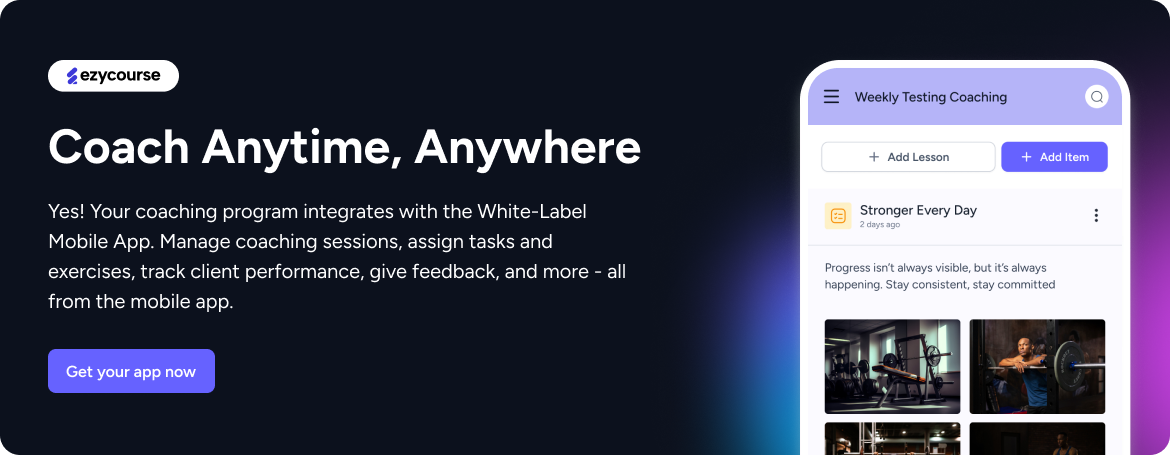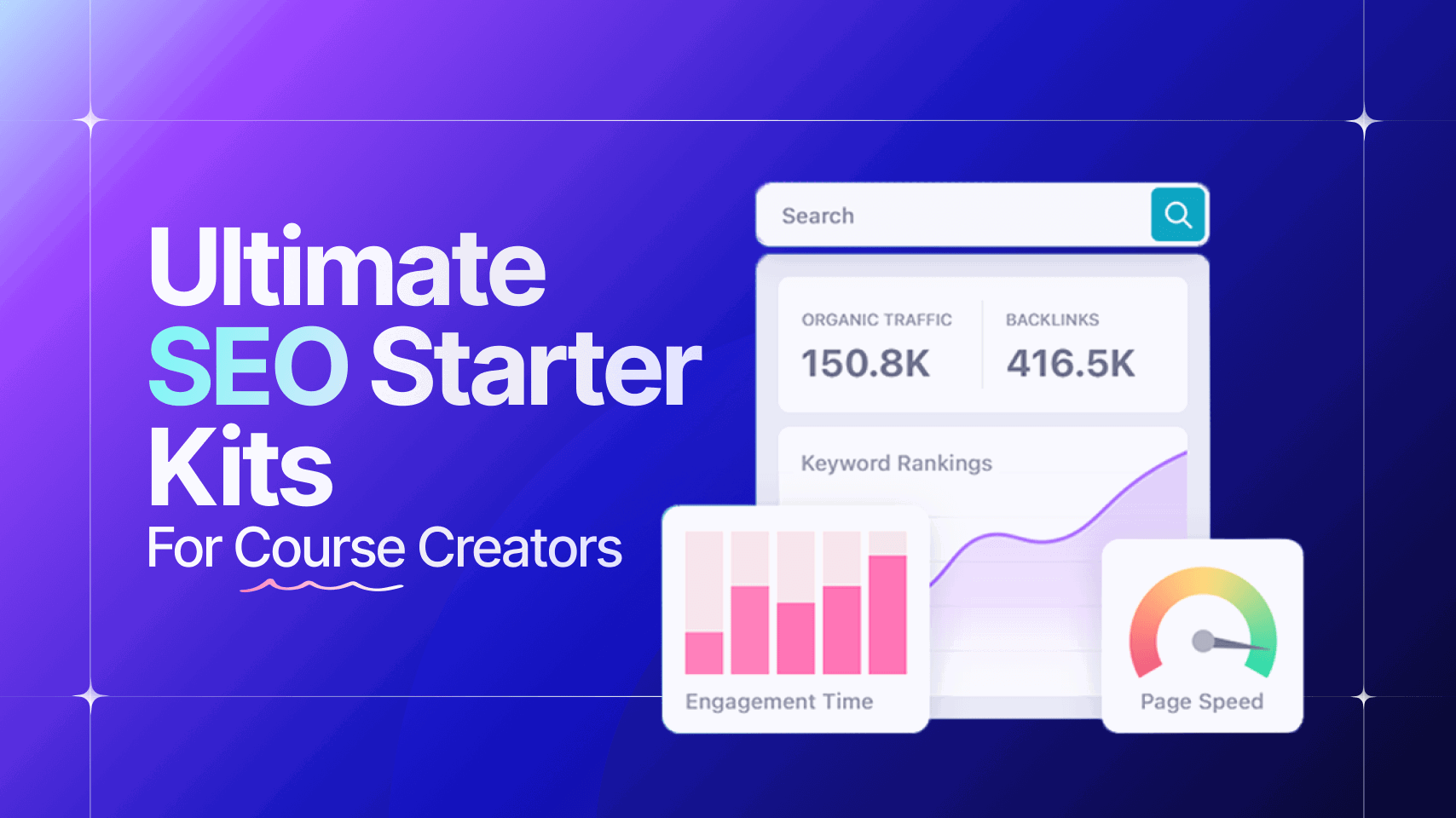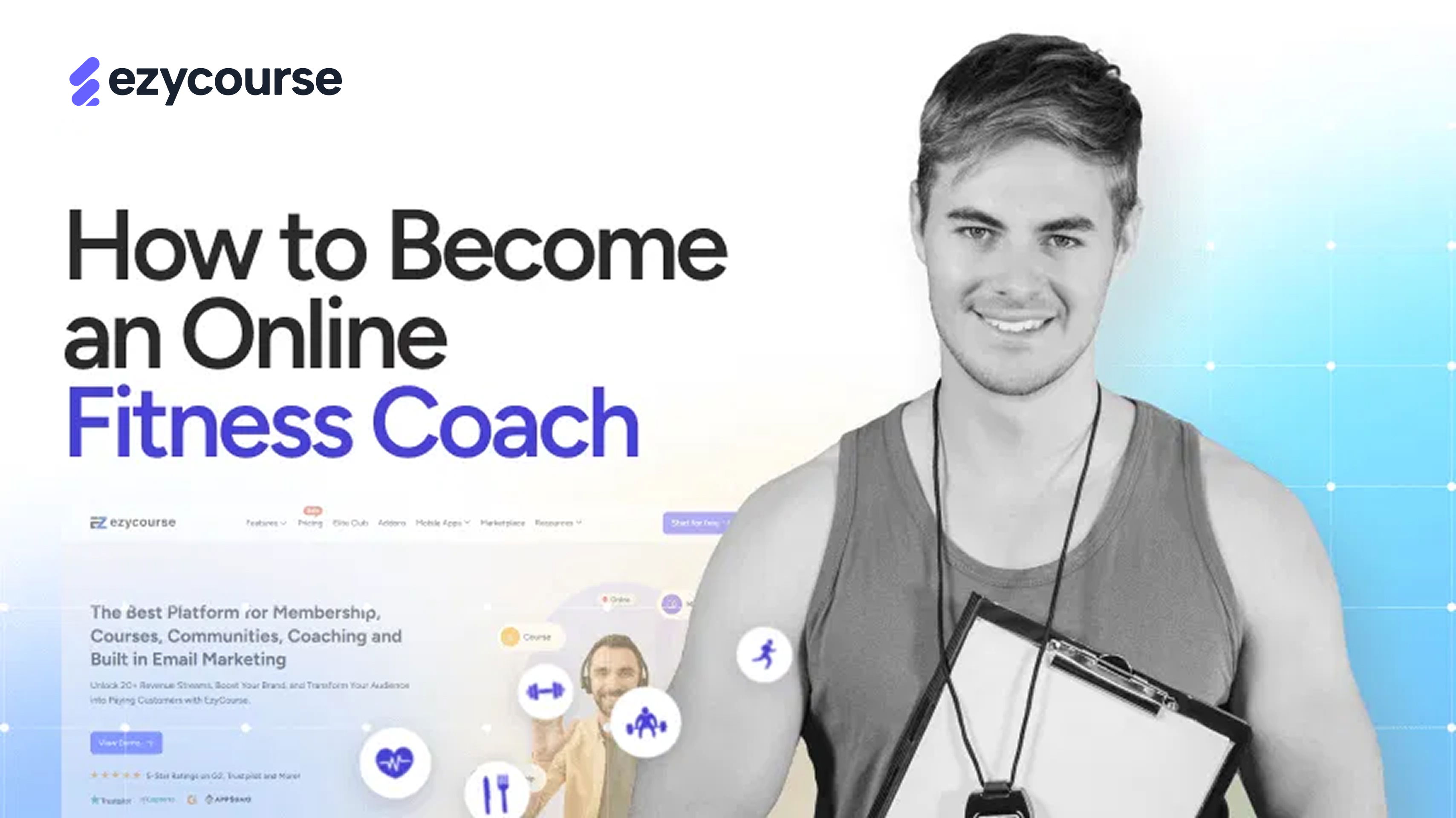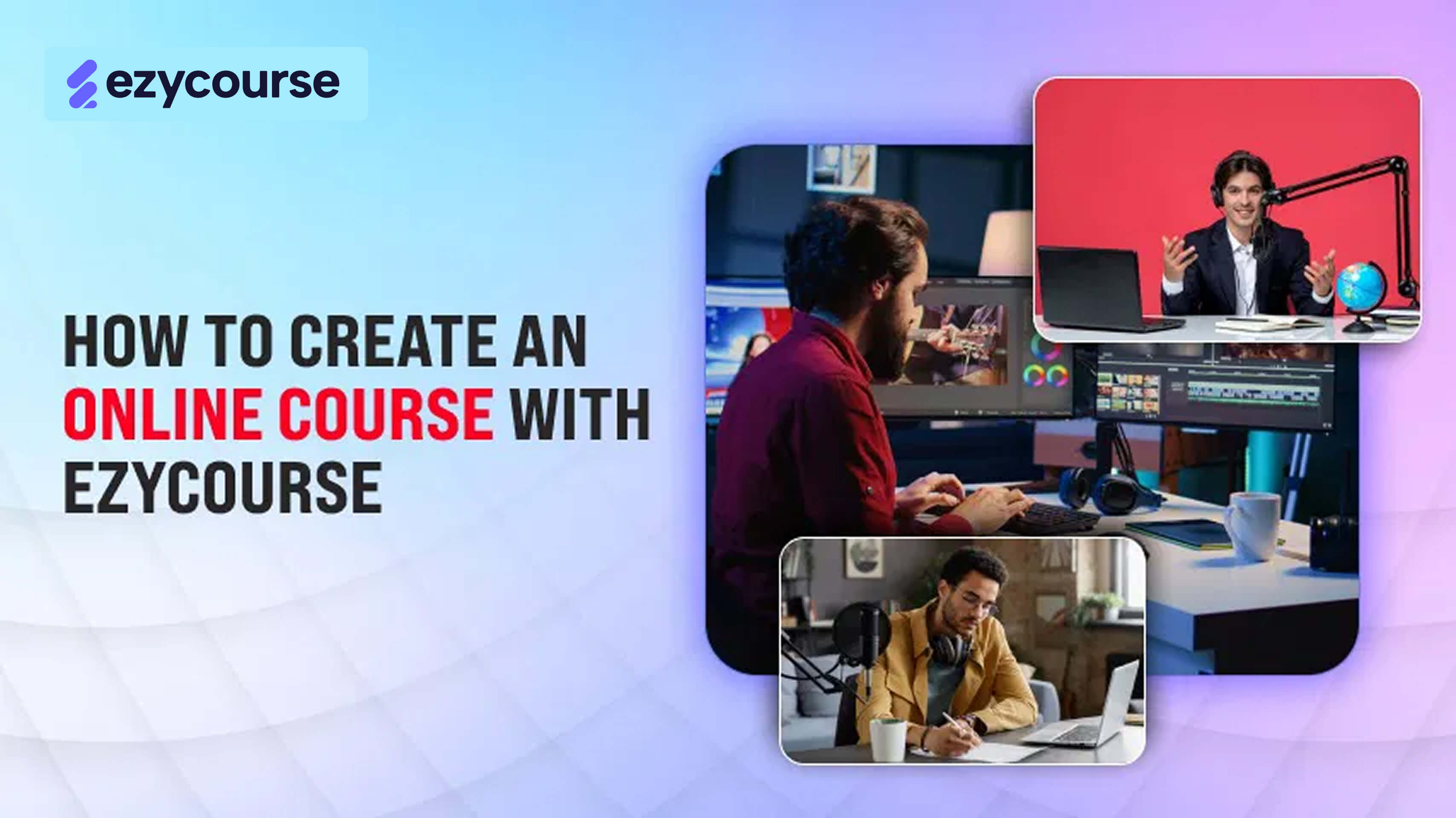How to Structure A Blog Post That Ranks and Converts
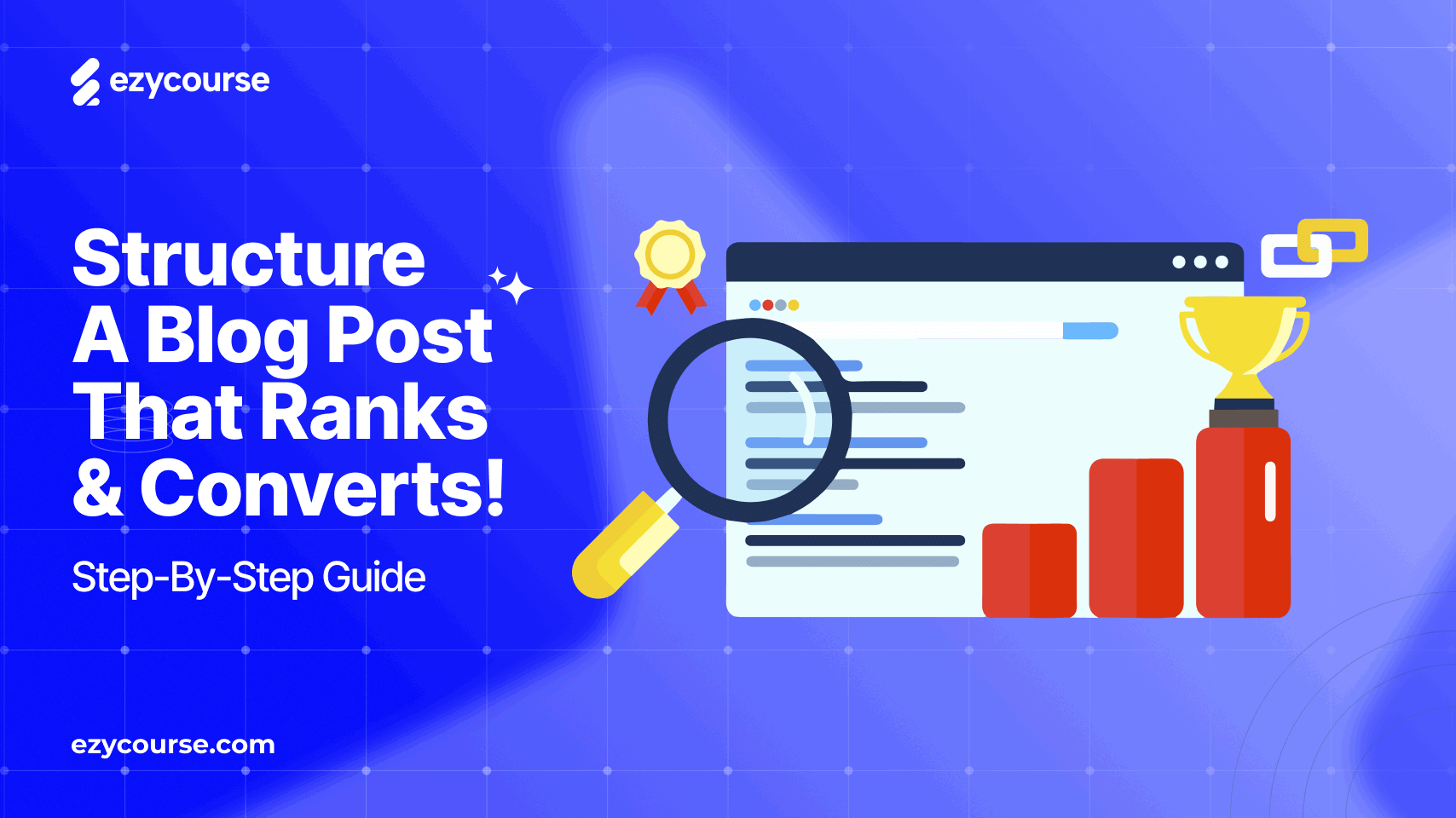
How to Structure A Blog Post That Ranks and Converts
Ranking on search engines isn’t easy. But it’s possible with the right tricks.
A well-written blog can do more than rank. It can turn readers into customers.
Do you know 70% of marketers want to grow their business using content marketing?
Importantly, the trick is to present your blog in an organized manner. This includes making interesting headlines, using bullet points, placing critical phrases strategically, and keeping paragraphs short.
Also, describing the next thing you want them to do, like signing up or purchasing, helps transform visitors into fans or customers.
In this blog, we’ll show you how to write SEO blog posts that rank and convert in 2025.
Interested in improving your blog? Let's begin!
What Is an SEO Blog Post
An SEO-friendly blog post is a content optimized to rank well in search engine results pages (SERPs).
To write an SEO blog post, you have to consider SEO best practices. The best part about a blog post? It can bring in organic traffic from search engines long after it's published.
For example, let’s see the organic search traffic results for Semrush Blogs:
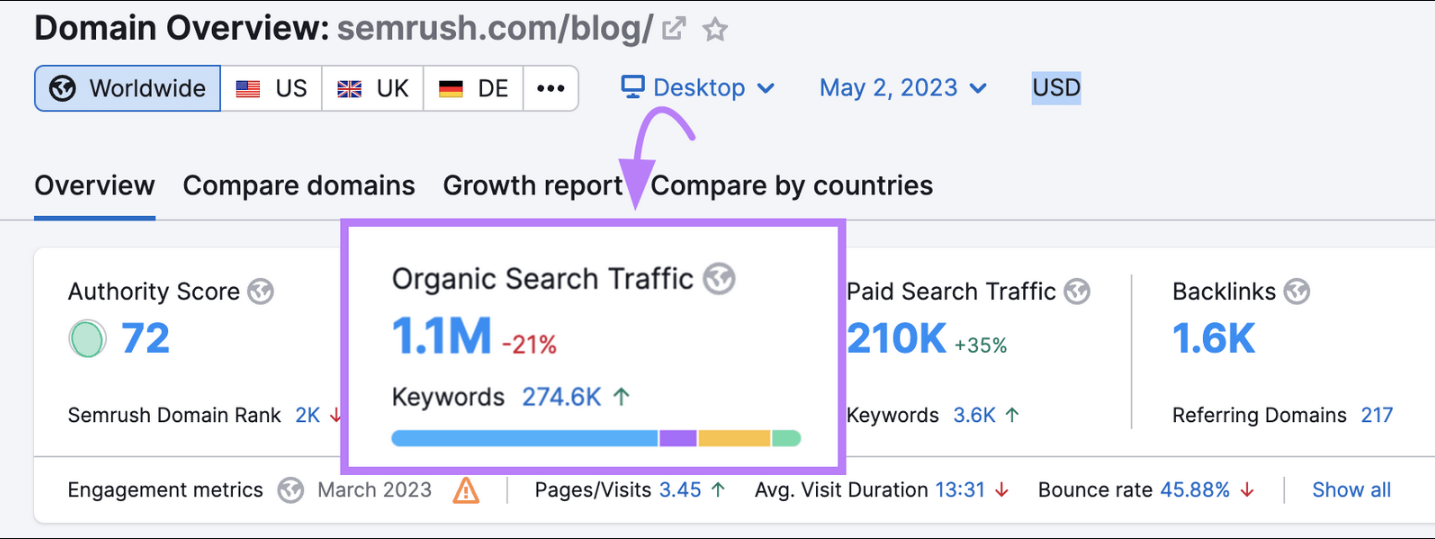
Why Should You Write a Blog Post
Every blog post has different objectives that you wish to achieve based on your audience and your intent. Below are the most common purposes to start blogging:
Educate and Inform
Break down complex topics into simple forms and help your readers learn something new.
Example:
A nutritionist could write: “10 Super Foods Good for Your Heart”
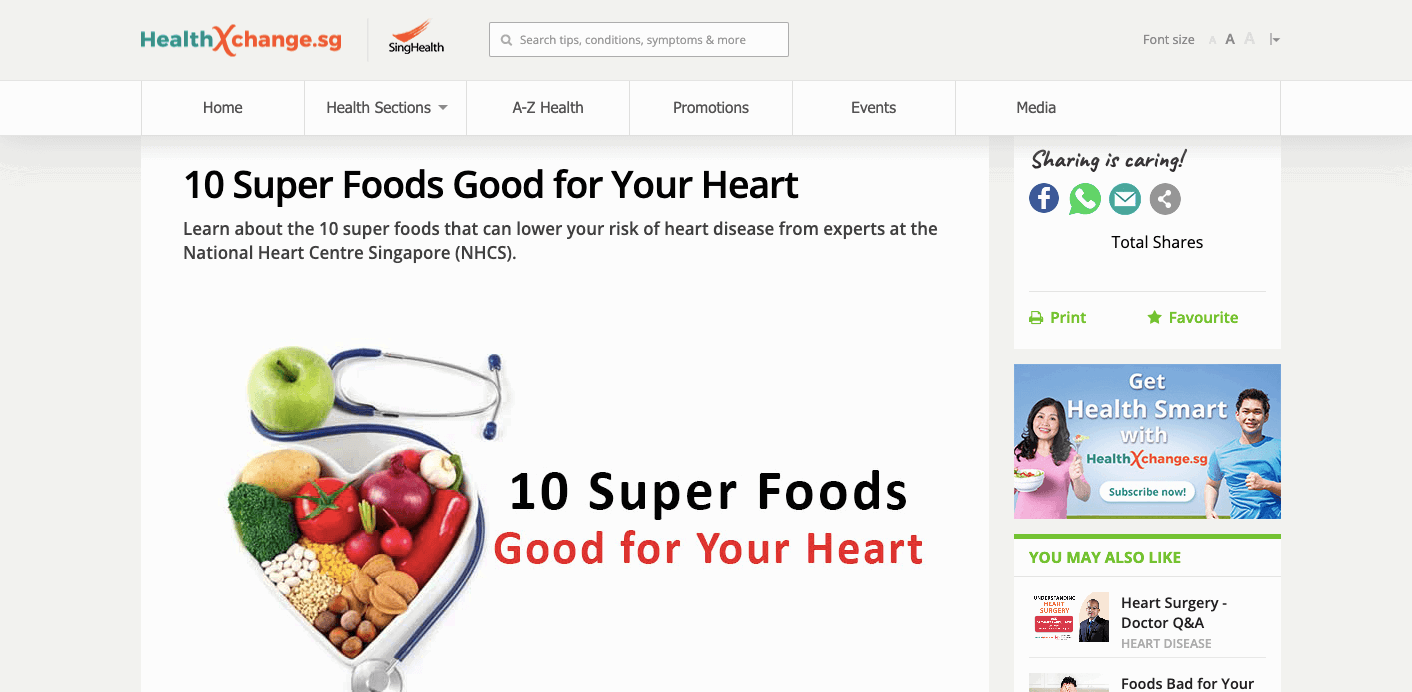
Share Opinions or Personal Stories
Create a comparable brand voice and share your unique insights and experiences.
Example:
A travel blogger could write: “What I Learned Hiking the Inca Trail Alone.”
Share Products or Services
Describe the importance of what you offer with real value and drive conversions smoothly.
Example:
A fitness coach could say: “Why You Should Join My 30-Day Home Workout Challenge.”
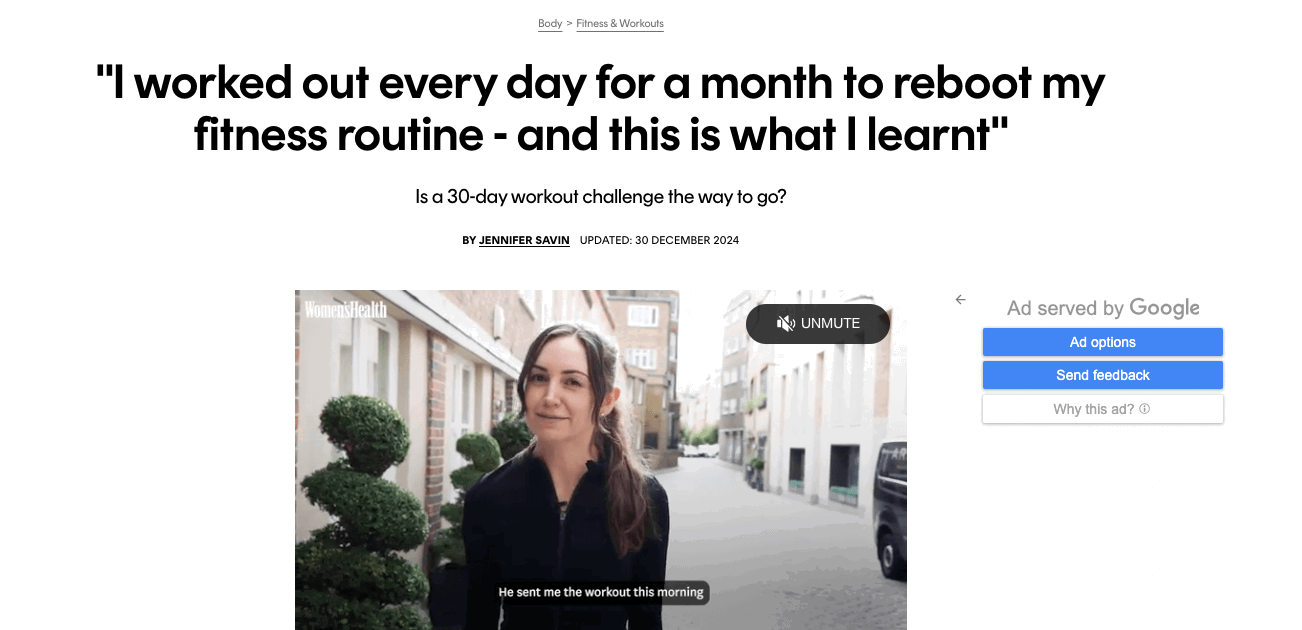
Establish Trust and Authority
Share expert opinions, statistical data, and guides to make yourself a credible voice.
Example: “Freelancer Contracts: What To Include And Why It Matters” by a legal consultant.
Entertain and Engage
Create posts that are entertaining and engaging readers using storytelling, humour, or a captivating story.
Pop Culture Blog. “10 Times TV Shows Got Real Life Wrong.”
Everyone Loves to Ask Questions
Blogs that highlight keywords or solutions to frequent questions, problems, and queries are ideal for FAQs while also becoming snippets.
An eCommerce Example is “What’s the Difference Between Cold Brew and Iced Coffee?”
Start Conversations
Many blogs invite comments and encourage reader feedback, helping you build a community around your content.
Example:
An entrepreneur blogging: “What’s the One Habit That Changed Your Business?”
(And asking readers to share in the comments.)
Generate Leads
With strategic CTAs (call-to-actions), blogs can drive readers to sign up for newsletters, download lead magnets, or try demos.
Example:
“Want My Free Blog Post SEO Checklist? Download Here!”
Support Other Channels
Blog posts can be repurposed into:
Social media content with posts and copies
YouTube videos (and scripts)
Courses (via EzyCourse)
eBooks, PDFs, and other forms of lead magnets
How to Write & Structure SEO Blog Posts That Rank and Convert in 2025
We all need to know how to write SEO blog posts that perform well on Google and drive real action from readers. In 2025, it’s all about delivering value, improving user experience, and understanding search intent.
Here’s how to structure your blog posts to improve rankings, increase engagement, and boost conversions.
1. Craft a Scroll-Stopping, Keyword-Optimized Title (H1)
Your blog post title is the first thing people see on Google, social media, and even on your own site. It needs to:
Grab attention
Match the search intent of your ideal readers
Contain your main keyword
Spark curiosity
Promise clear value
Best practices for optimizing a title:
Use numbers to suggest a list (e.g., "10 Tips", "5 Strategies").
Start with a question about the topic that solves a common problem.
Use trigger words like “easy,”” “new,” or “ultimate.”
Use power words and emotional triggers like:
“Ultimate,” “Proven,” “Step-by-Step,” or “Beginner-Friendly”
“...That Work,” “...You Didn’t Know,” “...To Avoid in 2025”
Examples:
You can check and improve Your Blog Titles with AISEO. Below is a step by step guide:
Step 1: Visit the AISEO Title Analyzer Tool
Go to the AISEO website and locate their free Title Analyzer Tool. This tool evaluates your blog titles for SEO effectiveness and clickability.
Step 2: Enter Your Blog Title

Type or paste your current blog title into the input box. For example: "10 Easy Healthy Eating Tips to Boost Your Energy in 7 Days."
Step 3: Get Your Title Score
Click the analyze button. AISEO will score your title, usually out of 100. For instance, you might get a score of 69, indicating room for improvement.
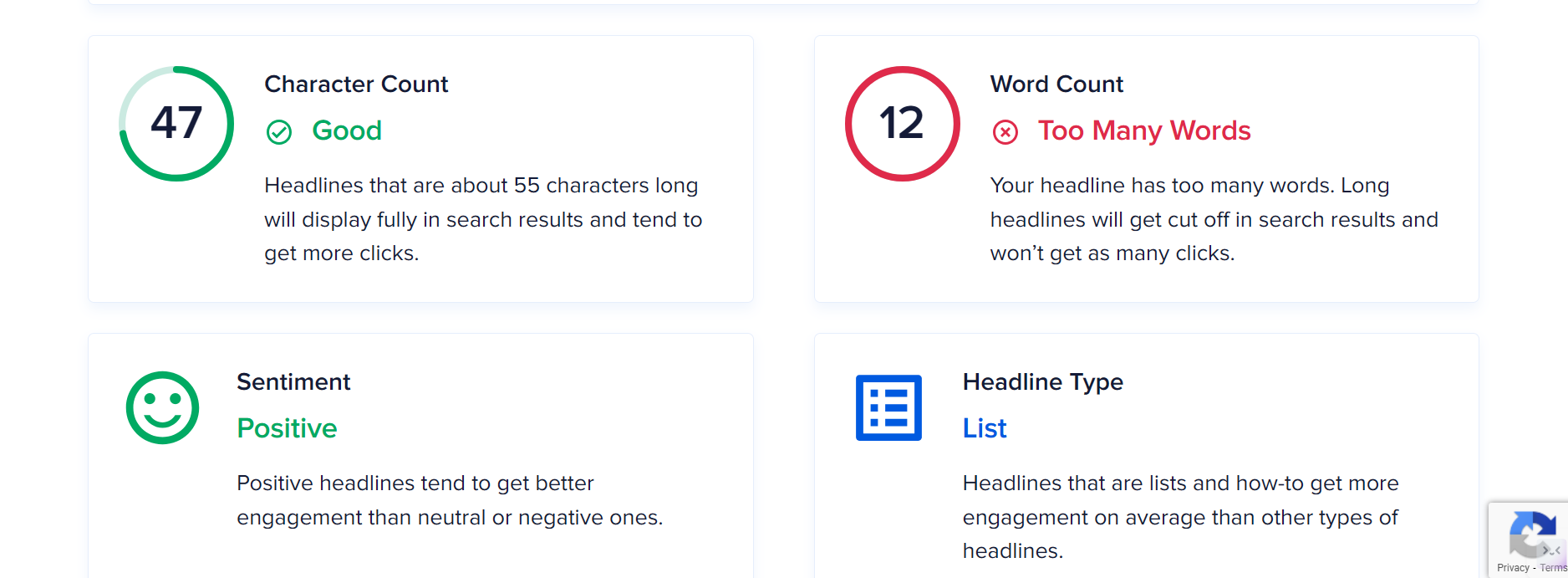

This score reflects how well your title follows SEO best practices.
Step 4: Review Suggestions
AISEO provides actionable suggestions, such as adding numbers or power words or making the title more specific and engaging.
Step 5: Rewrite Your Title

Use these suggestions to craft a more compelling title. For example, revise it to: "10 Proven Healthy Eating Tips to Instantly Boost Your Energy."
Step 6: Re-Analyze Your New Title

Enter the revised title back into AISEO to check if the score improves. It's showing 72, which is very good. Still, it needs improvement. Continue tweaking until the score is high.
Step 7: Use Your Optimized Title
Once satisfied with the score, apply the optimized title to your blog post to attract more clicks and improve SEO.
Step 8: Monitor Performance
After publishing, track your post's traffic and engagement. Using the same process, refine future titles using AISEO. Well-optimized titles increase click-through rate (CTR), which signals relevance to Google and improves ranking over time.
2. Write a Concise, Engaging Introduction That Hooks Readers
A concise and engaging introduction is key to immediately grabbing your readers’ attention. A strong intro hooks the reader by clearly stating what the post is about and why it matters to them.
It sets the tone, sparks curiosity, and encourages people to keep reading. Keep it brief, use simple language, and focus on the benefits your reader will get from the content.
Now, think of your introduction as a mini elevator pitch. You have only a few seconds to tell readers:
Why they should care
What you’ll help them with
What they’ll get out of reading
However, most readers bounce within 10 seconds. Your opening should:
Acknowledge their problem or pain
Use conversational tone to build trust
Introduce your solution (the blog)
Essential Tips to Follow:
Start with a relatable problem, surprising stat, or question.
Mention your target keyword naturally within the first 100 words.
Keep it short.
Hint at a benefit or outcome.
Example:

You can start like this way. You are giving your readers the hope to do great things, and your content will guide them. This helps users know exactly what to expect and keeps them reading.
3. Add a Clickable Table of Contents (TOC)
So, you have added an attractive heading and intro. Now, move on to the table of contents.
Actually, a table of contents makes it easy for readers to navigate your content, especially longer posts and helps search engines understand your structure.
With EzyCourse, you will get the Table of Contents ready automatically. In WordPress, you have to use plugins like Easy Table of Contents or generate one manually using anchor links.
This is especially helpful if your content is long-form. TOCs:
Help readers scan and jump to relevant sections
Improve dwell time and navigation
Enhances user experience (UX)
Helps Google generate jump links in search results
Increases time on page by allowing users to jump to what they care about
Example TOC for the blog “How to Become an Online Fitness Coach” on EzyCourse:

If you're hosting blog posts on EzyCourse, the platform allows automatic TOC generation in course modules and blog sections. It’ll make your content easier to navigate and more SEO-friendly.
4. Create Long-Form, User-Focused Content That Solves Real Problems
Now, it’s time to add a perfect content. Google favors high-quality, in-depth content that answers user intent fully.
Best Practices:
Aim for 1,500–2,500+ words for evergreen or pillar posts.
Use data, examples, and quotes from experts.
Break content into readable chunks with plenty of visual elements.
Use natural language write like you’re talking to a friend.
Regularly update old content to keep it fresh and relevant.
Long-form content shows topic authority and earns backlinks, both key to ranking high in 2025.
Pro Tip: Test multiple titles using A/B split testing if you’re publishing on your own website or using a smart platform like EzyCourse, which offers advanced blog and funnel tools.
5. Use Clear Headings (H2, H3) to Organize Your Content
Headings aren’t just for looks they guide readers and search engines. A well-structured blog post uses:
H1 – Your main title (used once)
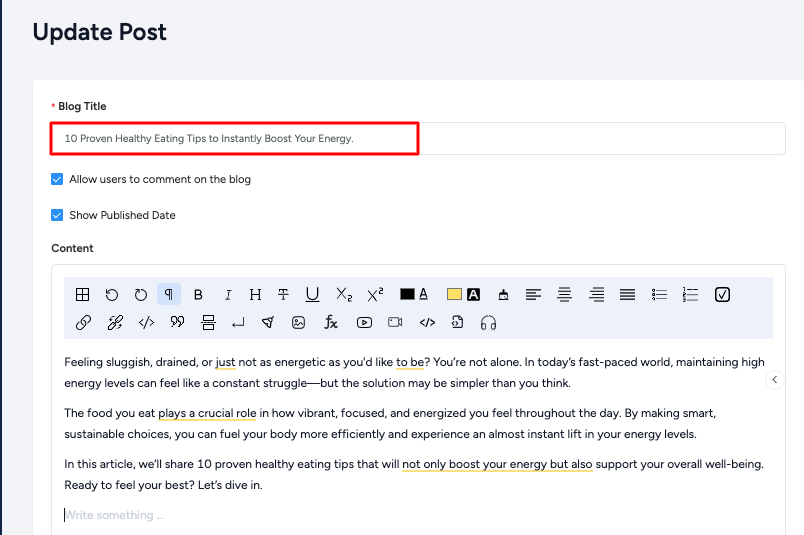
H2 – Key sections
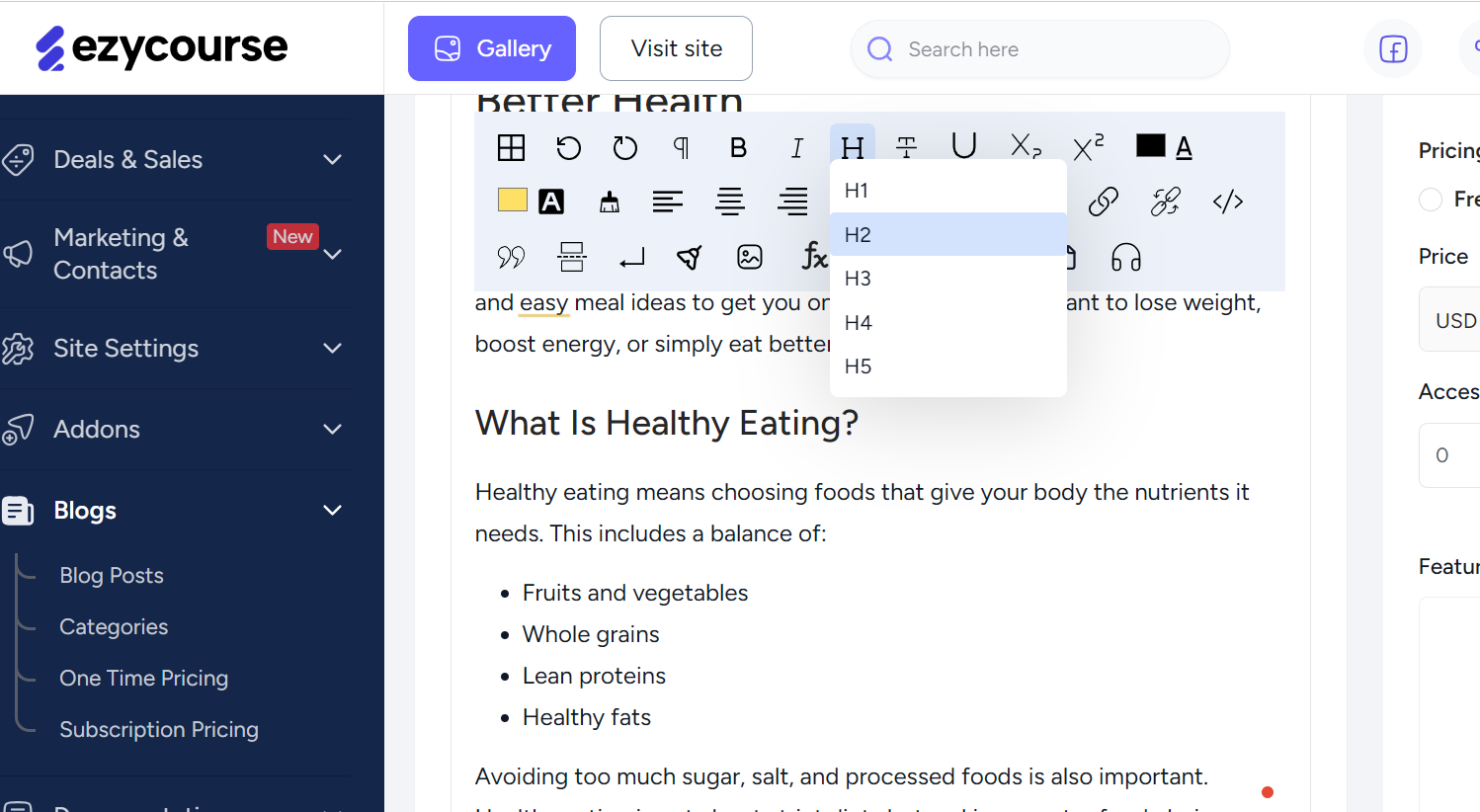
H3 – Subsections or details
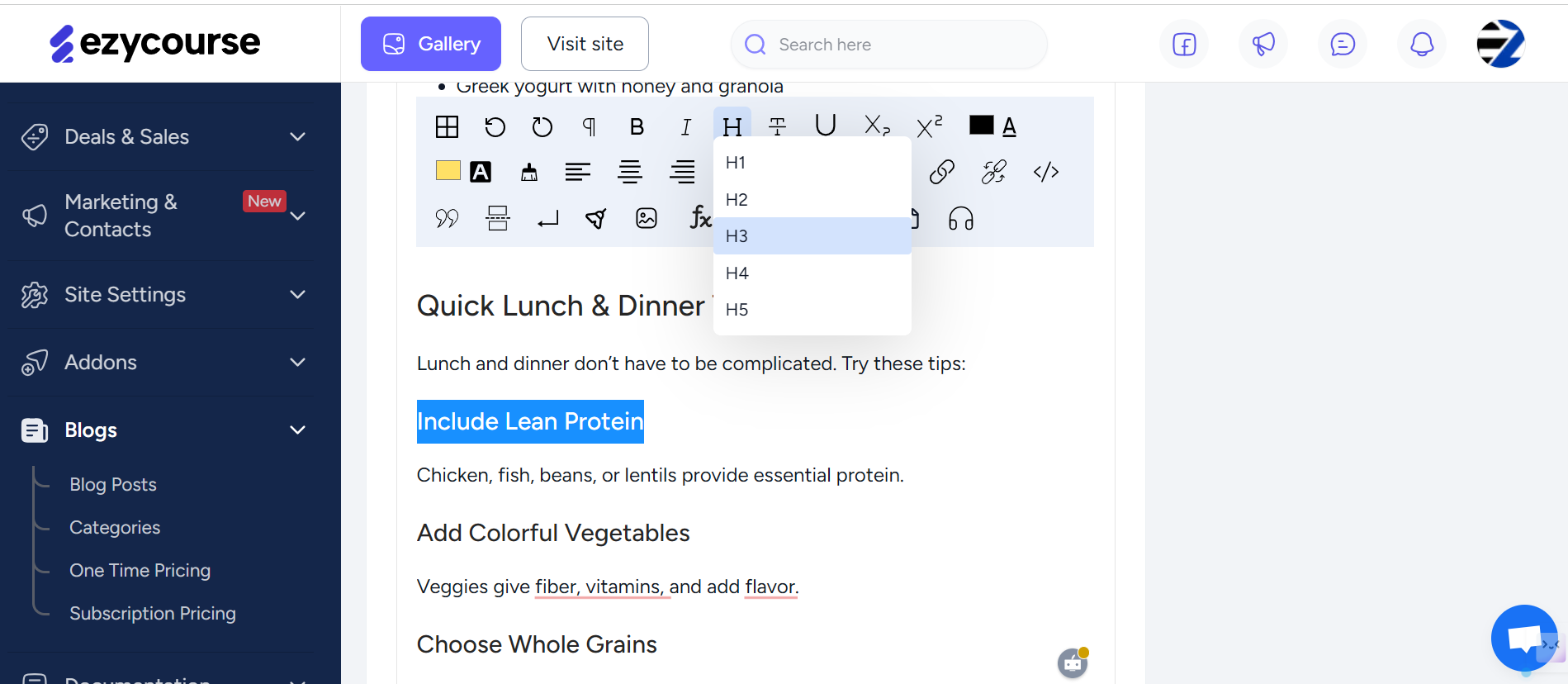
Use H2 tags for main sections and H3 tags for subpoints. This helps:
Google better understand the structure
Readers skim content quickly
Improve chances of getting featured snippets
Also, use clear, keyword-rich headings like:
H2: Top 10 SEO Blog Structures That Work in 2025
H3: Why Mobile Optimization Is Now a Ranking Factor
A good structure increases the possibility of higher engagement and better rankings.
6. Use Short Paragraphs and Lists for Readability
Online readers scan they don’t read every word. Make your content easy to digest:
Do:
Keep paragraphs to 2–3 sentences max
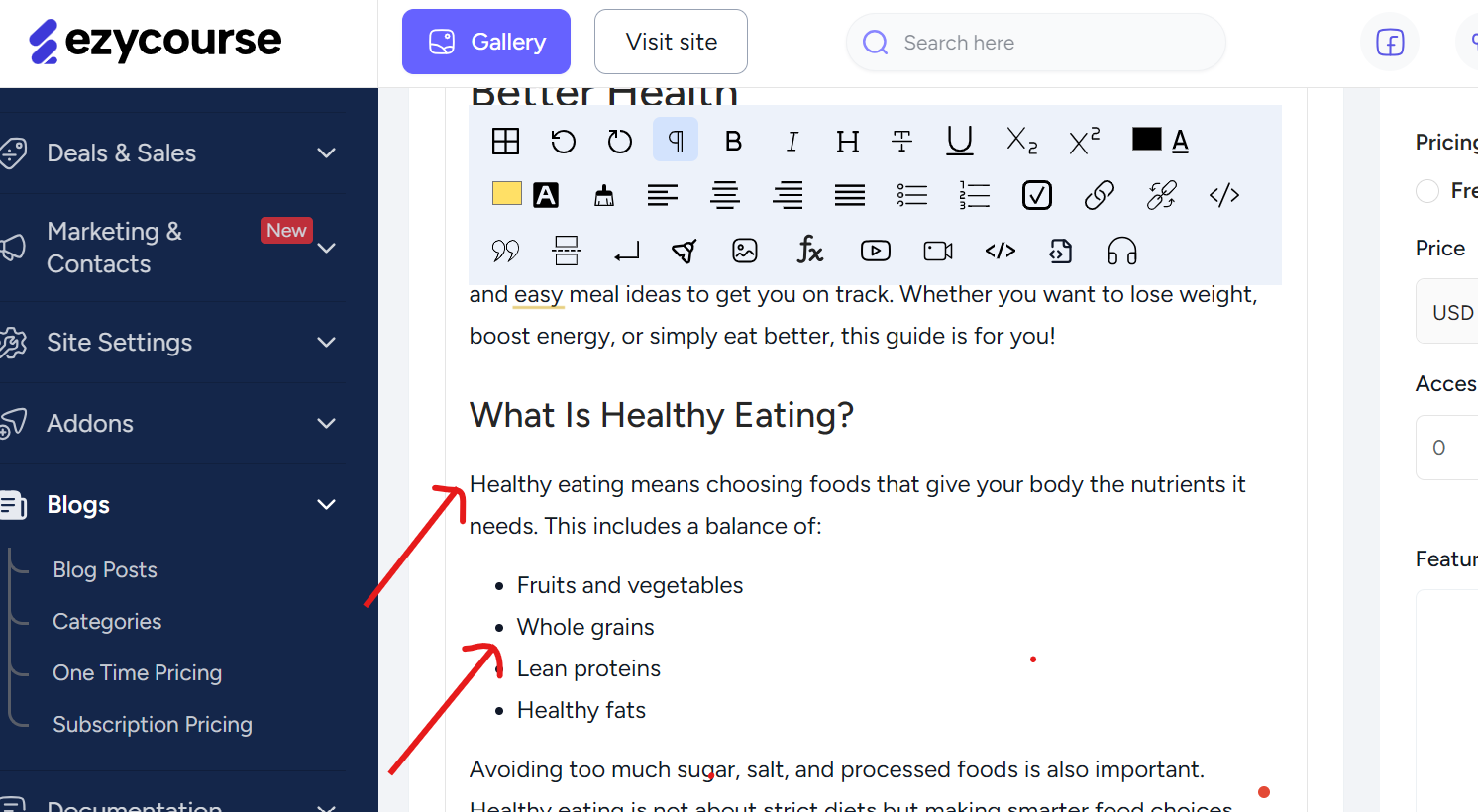
Use bullet points or numbered lists for key takeaways
Add bold text for emphasis
Don’t:
Write long blocks of text
Use complex words or jargon
Example:
Instead of this:
Blogging is important for online business growth because it helps increase organic traffic, build brand authority, and educate your audience about your products or services, ultimately leading to more sales.
Write it like this:
Blogging is a powerful growth tool.
Here’s why:
It attracts organic traffic
Builds your brand authority
Educates readers (and converts them into customers)
Better UX = Better SEO.
This improves user experience, reduces bounce rate, and encourages longer time on page all great for SEO.
7. Add Multimedia (Images, Videos, Infographics)
Visual content helps break up text, explain complex ideas, and keeps users engaged.
Suggestions:
Images with descriptive alt text
How-to videos, screen recordings, or animations
Interactive elements like quizzes or polls
Use relevant images or diagrams
Add short videos to explain key points
Use infographics for stats or processes
Include GIFs or memes if the tone allows
Bonus SEO Tip:
Always include alt text on images with your target keywords to improve image SEO.
If you're sharing a recipe, include:
A photo of the dish
A step-by-step infographic
A 60-second video tutorial
If you’re using blogging platforms like EzyCourse, you can embed your course previews, video modules, or even private podcast content right into your blog. This is an excellent way to drive traffic to your paid offerings from your free content.
8. Use Internal and External Links Smartly
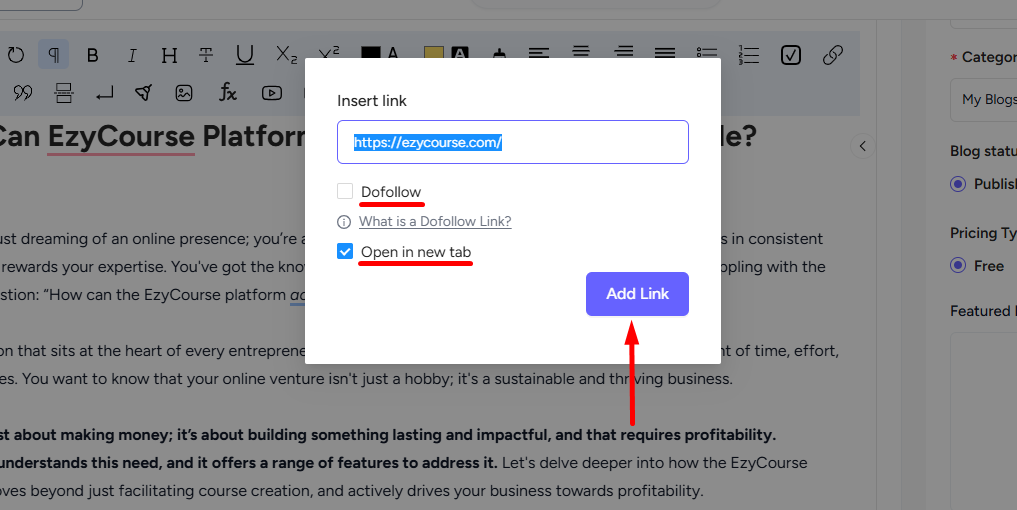
Linking adds credibility, builds context, and keeps readers exploring your site.
Internal Links:
Link to related blog posts or products
Use descriptive anchor text (not “click here”)
Example:
Read our full guide to intermittent fasting before you start.
External Links:
Link to trusted sources
Only use relevant, up-to-date content
Both internal and external links signal quality and authority to Google.
Note: With EzyCourse, you can add both dofollow and nofollow links right inside the blog editor.
9. Use Conversion-Driven CTAs Throughout (Not Just the End)
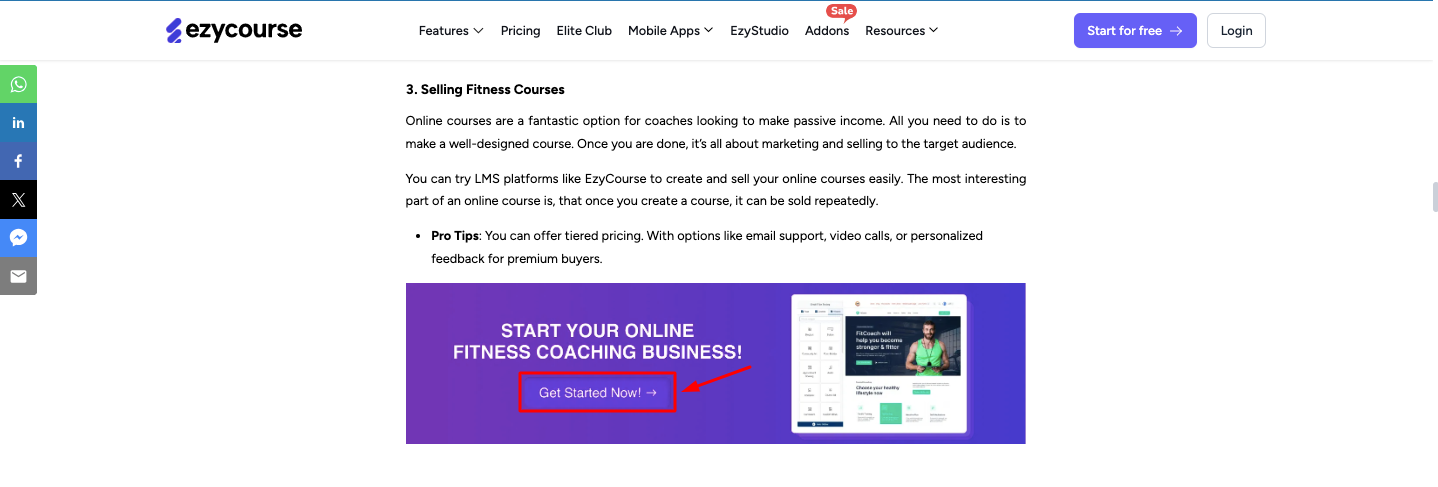
Don't wait until the end to promote your product or offer. Use contextual CTAs throughout your post.
Examples:
At the start:
New to blogging? Try EzyCourse’s free blog builder and start ranking from day one.In the middle:
Want to turn blog readers into students? EzyCourse lets you link blog posts to gated courses with one click.At the end:
Ready to start blogging smarter? Create your free EzyCourse account and access tools to blog, sell, and scale—without tech headaches.
10. Finish with a Powerful Summary + Next Step
Wrap up with:
A quick recap of the blog’s value
A clear action readers should take next
Example:
Structuring your blog properly isn’t optional, it’s the key to standing out in 2025. From clickable titles to internal linking and smart CTAs, every section plays a part.
Want a blogging tool that helps you write, monetize, and grow all in one place? Start free with EzyCourse and see how easy it is to turn readers into customers.

Bonus Tips: Use SEO & Technical Best Practices Behind the Scenes
Many bloggers forget about these technical SEO pieces. But they matter a lot. So, don’t forget to optimize:
URL Slug: Keep it short and keyword-focused
Do: /blog/healthy-eating-tips
Don’t: /blog/what-you-should-know-about-the-new-way-of-eating-healthily-in-2025Meta Description:
Use 150–160 characters to summarize the blog with keywords.
Example: Discover 10 simple healthy eating tips to boost energy, reduce fatigue, and feel better every day.
Alt Text:
Add keyword-rich descriptions to all images.Mobile Optimization: Make sure your blog loads fast and looks great on mobile over 60% of traffic comes from smartphones.
How Can You Start a Blog Post?

Truly speaking, starting a blog post is key to attracting readers and keeping them interested. Here’s how to write SEO blog posts step-by-step.
Step 1: Understand Your Audience and Purpose
Before writing, ask yourself:
Who am I writing for?
What do they want?
For example, if your audience is beginners learning guitar, your blog post should avoid jargon and explain basics clearly.
Your purpose could be:
To educate (e.g., “How to Play Your First Chord”)
To inspire (e.g., “My Journey to Mastering Guitar”)
To sell (e.g., “Join My Online Guitar Course Today”)
Knowing this guides your tone and content.
Step 2: Choose a Relevant and Specific Topic/Keywords
A focused topic helps you target the right readers and rank better on search engines.
Example: Instead of “Guitar Tips,” write “5 Easy Guitar Chords Every Beginner Should Know.”
Use tools like Google Keyword Planner, Ubersuggest, or AnswerThePublic to find topics people are searching for.
Read the guide to learn How to Find the Right Keywords for Your Course.
Step 3: Write a Captivating Title
Your title is your blog’s headline, it should grab attention and contain keywords for SEO.
Good titles often use:
Numbers: “7 Ways to…”
How-to format: “How to Learn Guitar in 30 Days”
Questions: “What’s the Best Guitar for Beginners?”
We’ve already provided tips on this earlier. Keep those tips in mind.
Step 4: Research Your Topic Thoroughly
Gather accurate and relevant information to provide real value.
Use:
Credible websites
Books or guides
Interviews or expert quotes
This builds trust with your readers.
Then again, you have to find rel
Step 5: Create an Outline
Organizing your ideas before writing helps keep your blog clear and easy to follow. Here’s an example outline for a post titled “How to Start Running for Beginners”:
Introduction:
Why running is a great exercise for health and fitness
Benefits of starting slow and building gradually
Section 1: Getting Ready to Run
Choosing the right running shoes
What to wear for comfort and safety
Importance of warming up before running
Section 2: Beginner Running Plan
Week 1: Walking and jogging intervals
Week 2: Increasing running time gradually
Tips to avoid injury and stay motivated
Section 3: Tracking Progress
Using apps or journals to log runs
Setting realistic goals and celebrating milestones
Section 4: Nutrition and Hydration Tips
What to eat before and after running
Staying hydrated for better performance
Conclusion:
Encouragement to stick with the routine
Reminders about listening to your body
Next steps: Joining running groups or signing up for a race
Step 6: Write an Engaging Introduction
Begin your introduction with something that grabs attention and makes readers want to continue:
A Question: “Have you ever wanted to cook delicious meals without spending hours in the kitchen?”
A Fact: “Studies show that simple home-cooked meals can improve your health and save money.”
A Brief Story: “I used to rely on takeout every night until I discovered easy recipes that transformed my cooking skills.”
After your hook, clearly tell readers what they will learn in your post and why it’s important to them. This helps set expectations and encourages them to keep reading.
Step 7: Develop the Body Content Clearly
Explain each idea using simple, easy-to-understand language. Make your content easy to read and follow by using:
Short paragraphs to avoid overwhelming readers
Bullet points or numbered lists to organize steps or tips
Examples or stories to help explain concepts
Images or videos to visually support your explanations
Example:
How to Brew the Perfect Cup of Coffee
Use fresh, quality coffee beans
Grind beans just before brewing
Use clean, filtered water heated to about 200°F (93°C)
Measure 1 to 2 tablespoons of coffee per 6 ounces of water
Brew for 4 minutes using a French press or drip coffee maker
Pour and enjoy your fresh, flavorful coffee
(Include a step-by-step image or brewing video)
Step 8: Write a Clear Conclusion and Call to Action (CTA)
Summarize the key points briefly. Encourage the reader to take action.
We’ve shown you earlier how to add a proper call to action in your blog.
Step 9: Edit and Proofread
Check for grammar errors, awkward phrasing, and clarity.
Reading aloud helps catch mistakes.
Use tools like Grammarly or Hemingway Editor for assistance.
Top 5 Best Platforms for Blogging in 2025
Looking to start a blog in 2025? Check out these five blogging platforms with customizable designs, SEO tools, and user-friendly interfaces.
1. EzyCourse
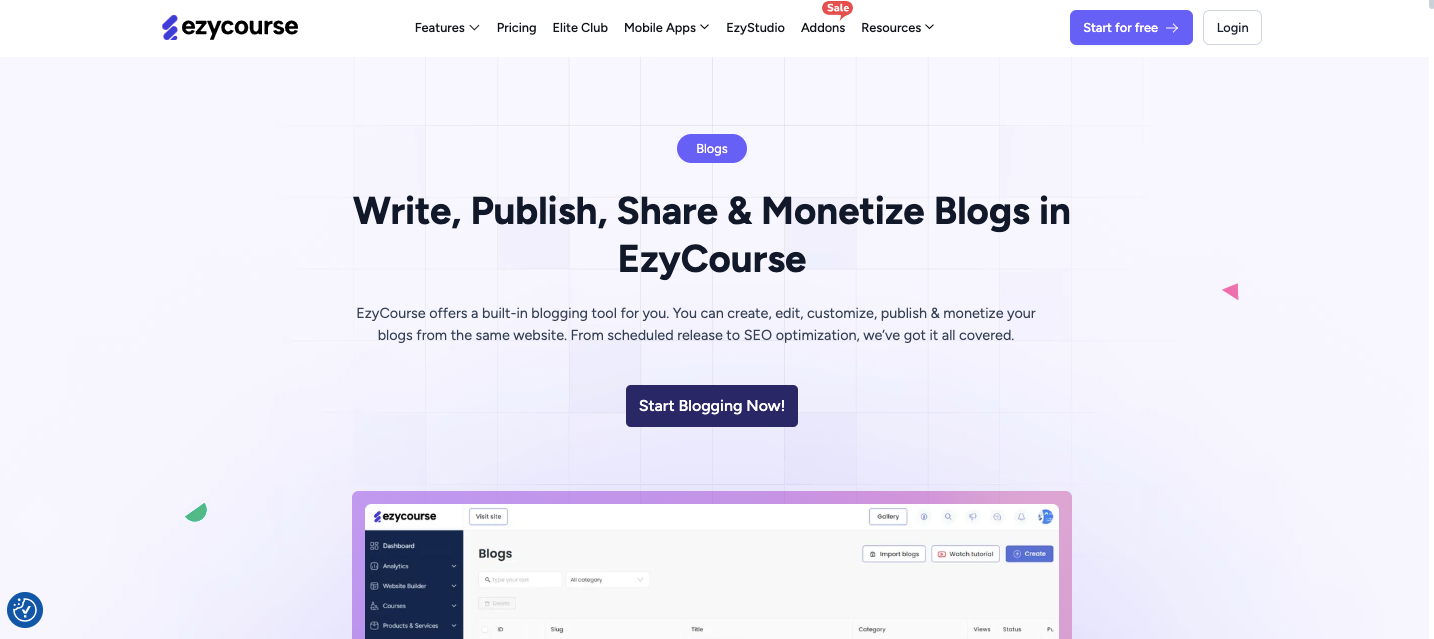
Instructors, coaches, and creators can use EzyCourse because it is a single unified solution designed to serve all their needs. On the same platform, you can create courses, communities, and blogs.
The blog editor, which is extremely user-friendly, also has functions that help your site rank in Google. It allows picture and video uploads, post scheduling, and the sale of blog posts.
Membership subscriptions can also be made available. EzyCourse provides Google Analytics to monitor EzyCourse and look at the traffic received. Post-sharing is made easier with the integration of social media.
For anyone seeking to combine their email and blog on one platform, this would be an excellent service.
It combines simplicity for beginners and complexity for those who seek to develop their businesses more online.
Who Can Create Blogs on EzyCourse?
Online course creators
Educators and trainers
Content marketers
Coaches and consultants
Anyone wanting to monetize blog content
EzyCourse Features
Simple Blog Editor: User-friendly editor allowing easy writing, editing, and formatting without coding.
SEO Tools: Built-in options to add meta titles, descriptions, and keywords to help your posts rank better.
Multimedia Support: Easily embed images, videos, and other rich media to make posts engaging.
Post Scheduling: Set dates and times to publish posts automatically.
Monetization Options: Sell individual blog posts or offer memberships with recurring or one-time payments.
Google Analytics Integration: Track visitor behavior, page views, and engagement directly within the platform.
Social Sharing: Built-in buttons to share blog posts on Facebook, Twitter, LinkedIn, and more.
Email Marketing Automation: Create automated email sequences to nurture your blog audience.
Community & Forum: Build a community where readers can interact, comment, and discuss your content.
Mobile Responsive Design: Blogs and courses adapt perfectly to phones and tablets

Pricing Details:
Basic – For Personal Creators
$45/mo
Unlimited courses, forms & custom pages
1 coaching program (20 clients)
Drip courses, 2 communities, 5 channels
Magic checkout, custom domain
Web push notifications, redirect tool
Pro – For Professional Creators
$139/mo
5 coaching programs (500 clients)
5 communities, advanced quizzes, gamification
Affiliate program & email marketing
Premium blog, blog membership
Free white-label apps & migration
Bonus Add-ons Worth $2,300+
Unlimited – True Unlimited Power
$199/mo
Everything in Pro + unlimited everything!
Zoom Premium (300 attendees)
DRM, site-wide memberships, advanced reports
100K marketing emails/mo
White-label apps + AI subtitle generator option
Bonus Add-ons Worth $5,800+
Elite – Best for Businesses & Agencies
$299/mo
All add-ons ($17K+ value)
Unlimited users, roles, and features
Premium, mobile apps, VIP support
500K marketing emails/mo
Direct access to CEO + dedicated tech team
Installments available
Is it Perfect for Blogging?
Absolutely! EzyCourse offers everything a hybrid blogger and course seller needs. Everyone can write good blog posts faster with the beginner-friendly post-editing feature.
Monetizing through paid posts or membership options is also available. A blog with enhanced SEO features is likely to attract a significant amount of traffic.
Email and community features are invaluable in staying engaged with blog readers. Beyond blogging, it is a multifaceted platform for building an online business through courses and blogs.
EzyCourse is the best Educator, Coach, or creator looking for a simple but powerful platform.
Good Things
Powerful SEO tools
Schedule posts in advance
Unlimited media embedding
Easy-to-use editor
Monetize individual blogs
Blog membership options
Social media sharing built-in
Google Analytics integration
Mobile-friendly design
Downsides (Cons)
No free forever plan

2. WordPress.com
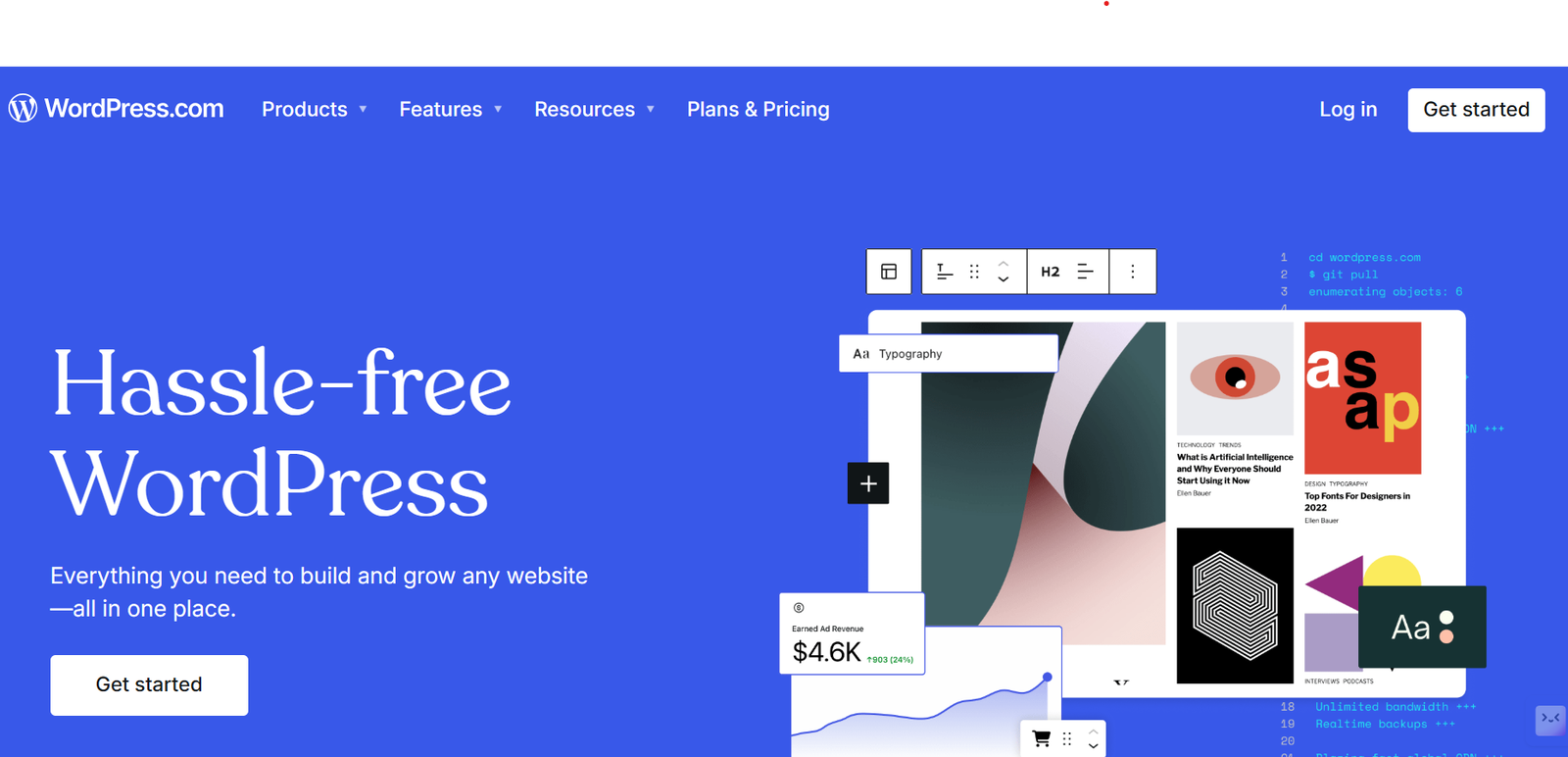
WordPress.com is the most popular blogging platform worldwide. It offers thousands of themes and plugins so you can design your blog exactly how you want.
It handles hosting and security, so you don’t need technical skills. You can add SEO tools, social sharing, and monetize your blog with ads or memberships.
WordPress.com works well for all bloggers from beginners to professionals. It lets you grow your blog from a simple site to a full-featured business.
Also, you can start free, then upgrade to paid plans for more options. The platform also has a large community and lots of help online.
Who Can Create Blogs with it:
Beginners to advanced bloggers
Small businesses
Hobby bloggers
Professional writers
Content marketers
WordPress.com Features
Extensive Theme Library: Thousands of free and premium themes for any style or niche.
Plugin Support: Add powerful features like SEO, security, e-commerce, and social media via plugins.
SEO Optimization: Tools and plugins to optimize content for search engines.
Monetization: Options for ads, affiliate marketing, memberships, and selling products.
Mobile-Friendly: Responsive designs that work on all devices.
Social Media Integration: Easy sharing and auto-posting to social platforms.
Automatic Backups & Updates: Managed hosting with automatic backups and security patches.
Custom Domains: Use your own domain name for branding.
Community Support: Large active forums, tutorials, and professional support.
Is it Perfect for Blogging?
Yes! Wordpress.com has something for everyone, no matter where you are in your blogging journey or what your goals are.
It’s very flexible with tons of design options and plugins. It handles the technical stuff like hosting, so you focus on writing.
You can easily grow your blog, add e-commerce, and make money. It also has many tools to help your blog show up on Google.
While it can initially feel tricky, many guides and community help make it easier. Overall, it’s one of the best choices for bloggers of all levels.
WordPress Pricing
Personal – $4/month
6 GB storage
Free custom domain for 1 year
Ad-free browsing
Dozens of premium themes
Expert support
Premium – $8/month
13 GB storage
All Personal features plus:
Advanced design customization
Google Analytics integration
Video uploads in 4K
Business – $25/month
50 GB storage
All Premium features plus:
Plugin and theme installations
SFTP/SSH, Git, WP-CLI access
WooCommerce support
24/7 priority support
Commerce – $45/month
All Business features plus:
Full eCommerce tools and store themes
Optimized WooCommerce hosting
Enterprise – Starting at $25,000/year
Scalable, secure, and data-driven solutions for large businesses
Good Things:
Huge theme/plugin library
Strong SEO support
Free plan available
Easy social sharing
Mobile-friendly
Good for all skill levels
Monetization options
Large community
Reliable hosting
Downsides:
Can be overwhelming for beginners
Some features need paid plans
Customization requires learning
Ads on free plan
3. Blogger
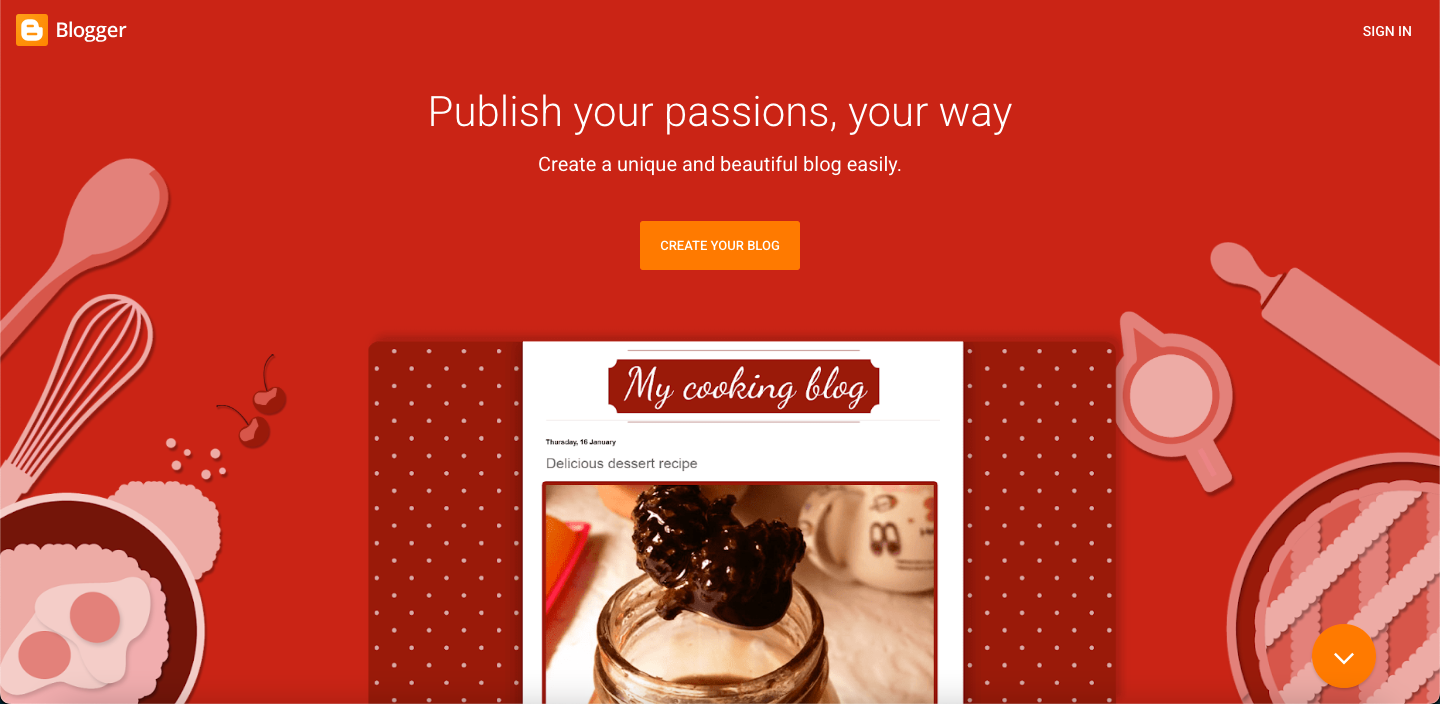
Blogger is Google’s free blogging platform. It’s very simple to use, making it perfect for beginners or casual bloggers.
You get free hosting and a subdomain like yourblog.blogspot.com. It works well with Google AdSense to help you make money with ads. Blogger also connects to Google Analytics so you can see your visitors.
The blog editor is basic but easy to learn. The platform offers only a few templates, so design options are limited. It’s good if you want to start blogging fast without costs or tech worries.
However, it’s less suitable for professional bloggers who want more control and style.
Who Can Create Blogs With it:
Beginners
Hobby bloggers
Casual writers
Google service users
Blogger Features:
Free Hosting: No costs for hosting or bandwidth.
Subdomain Provided: Blogspot.com subdomain or custom domain use.
Simple Post Editor: Easy to use editor for quick posts.
Google AdSense Integration: Monetize blog easily with ads.
Basic Template Selection: Choose from a handful of simple templates.
Comment Moderation: Manage reader comments and spam.
Mobile Compatibility: Basic responsive design for phones.
Automatic Backups: Google backs up your content.
Is it Perfect for Blogging?
For beginners or hobby bloggers, Blogger is a good place to start. It’s free and easy to set up, with no technical skills needed.
You can quickly write posts and make money with Google ads. But it has very few design options and basic features, so it won’t suit bloggers who want a professional look or advanced tools.
If you want a free, simple blog for personal use or learning, Blogger works well. For business or growing a serious blog, consider more flexible platforms like WordPress or EzyCourse.
Blogger Pricing Overview
Free Plan: Blogger is entirely free to use, including unlimited hosting and a Blogspot subdomain (e.g., yourname.blogspot.com).
Custom Domain: While Blogger doesn't sell domains directly, you can purchase a custom domain (e.g., yourname.com) through third-party registrars like Namecheap or Google Domains.
WPBeginner
Monetization: Blogger allows integration with Google AdSense, enabling you to earn revenue from ads displayed on your blog.
Cybernews
Customization: For enhanced design and functionality, you can purchase premium themes or hire developers. Some users have created professional-looking websites on Blogger for as little as $25 by utilizing affordable themes and custom domains.
Good Things:
Completely free
Easy to use
Google integration
AdSense monetization
Mobile-friendly
Basic SEO
Simple setup
Reliable hosting
Post scheduling
Downsides:
Limited design options
Less professional look
Fewer features than competitors
No advanced SEO tools
Limited support
Not ideal for business blogs
4. Wix

Wix is a website builder with strong blogging features. It has a simple drag-and-drop editor so you can design your blog without coding.
Wix offers hundreds of templates to make your blog look great on desktop and mobile. You can add pictures, videos, and social sharing buttons easily. Wix also includes SEO tools to help your blog get found on Google.
With Wix's e-commerce features, you can sell products or services alongside your blog. While Wix is easy for beginners, it is less flexible than WordPress for very custom blogs.
Who Can Create Blogs With It
Small businesses
Creative professionals
Beginners
Online stores
Content marketers
Wix Features
Drag-and-Drop Editor: Visually design your blog without coding.
500+ Templates: Professionally designed templates for blogs and websites.
Mobile Optimization: Mobile editor to customize the mobile view.
Social Sharing Buttons: Add sharing options to blog posts.
Multimedia Support: Embed videos, images, audio, galleries.
Post Scheduling: Plan and publish posts automatically.
E-commerce Integration: Add online store alongside your blog.
App Market: Add apps for extra functionality like live chat, forums, etc.
Is it perfect for blogging?
Yes, Wix is perfect for beginners who want a beautiful blog without technical stress. The editor is easy to use, and the templates are modern and mobile-ready.
Wix’s blogging tools cover all basics, and SEO help lets your posts rank on Google. It’s great if you want to add a store or portfolio too.
Wix Pricing Plans
Business Elite — $159/mo
Free domain for 1 year
Unlimited storage space
Multi-cloud hosting
Up to 100 site collaborators
Business — $36/mo
Free domain for 1 year
100 GB storage space
Multi-cloud hosting
Up to 10 site collaborators
Core — $29/mo
Free domain for 1 year
50 GB storage space
Up to 5 site collaborators
Light — $17/mo
Free domain for 1 year
2 GB storage space
Up to 2 site collaborators
All Plans Include:
Custom domain
Reliable web hosting
AI creation tools
24/7 customer care
99.99% uptime and security monitoring
Additional Info:
14-day money-back guarantee
Prices exclude VAT (based on billing country)
Good Things:
Beautiful templates
Easy drag-and-drop editor
Good SEO tools
Mobile-friendly
Post scheduling
Multimedia support
Monetization options
Analytics included
Free plan available
Downsides:
Free plan has Wix ads
Limited customization on free plan
Can be slower than others
Some SEO limits
Paid plans needed for full features
5. Squarespace
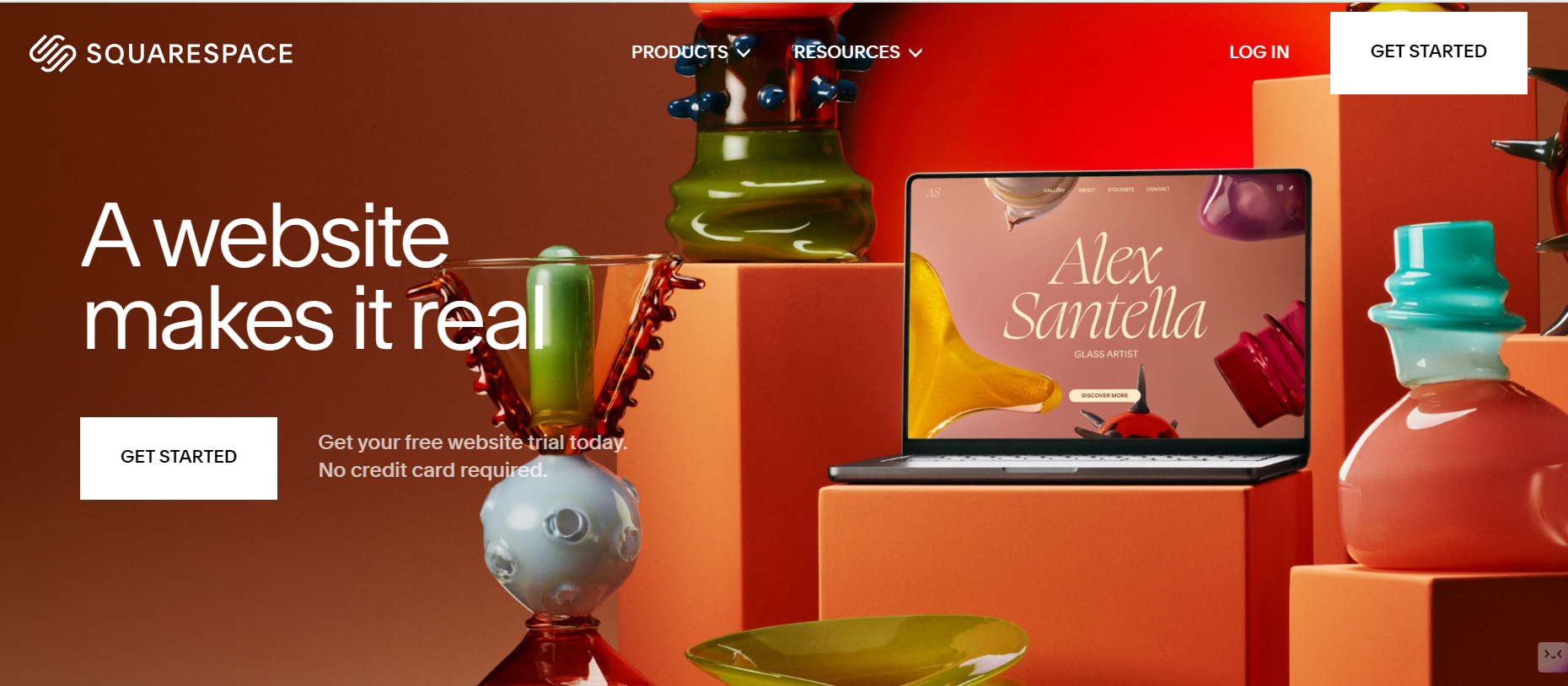
With Squarespace, users get beautiful designs and templates. Users can also schedule their posts into different categories and use tags. The editor does not require coding so anyone can use it, and it is simple to understand.
Besides blogging, users get integrated SEO, social media sharing, and analytics.
People can sell products through e-commerce, or memberships or even offer subscriptions.
Squarespace simplifies blogging by offering free hosting and security. Artists and smaller businesses looking for simple solutions love Squarespace because of its ease of use.
Squarespace Features
Beautiful Templates: Highly polished, mobile-responsive designs.
Blog Management: Categories, tags, drafts, and scheduled publishing.
SEO Settings: Customize titles, descriptions, and URLs.
Social Media Integration: Auto-sharing and social feeds.
E-commerce Ready: Sell products or services with payment options.
Membership & Subscription: Create gated content or paid memberships.
SSL Security: Secure your blog and visitors’ data.
Content Blocks: Drag and drop images, videos, quotes, and galleries.
Is it perfect for blogging?
If design is your focus, Squarespace is the perfect blogging tool.
Marketing and social sharing SEO tools are incorporated, so builders do not worry about increasing their blog’s popularity.
Like most builder platforms, flexibility becomes an issue, but Squarespace's customer support makes up for it.
With its easy-to-use analytics and blogging tools, Squarespace is the go-to option for creatives and small businesses focused on growth.
Squarespace Pricing Plan
Personal — $25/month
Mobile-optimized websites
Customizable templates
Free custom domain
Sell products & services
Send invoices, 0% transaction fee on invoices
Business — $36/month
All Personal features plus:
Advanced website analytics
Checkout on your own domain
Advanced shipping
3% transaction fee on online store sales
Commerce Basic — $40/month
All Business features plus:
No transaction fees on online store sales
Powerful merchandising tools
Commerce Advanced — $72/month (Save 27% annually)
All Commerce Basic features plus:
Advanced discounting
Sell subscriptions
No transaction fees on invoices or online sales
Who Can Create Blogs
Creatives
Small businesses
Photographers
Artists
Entrepreneurs
Good Things:
Gorgeous templates
Easy to use
Good SEO tools
Membership options
Mobile-friendly
Multimedia support
Social integration
Analytics included
Reliable hosting
Downsides:
Pricier than some
Less flexible than WordPress
Limited third-party apps
No free plan
Learning curve for some features
Limited customization on templates
Which Platform is Best for Blogging?
Generally, there are so many blogging platforms. But if you want an easy-to-use, powerful solution, EzyCourse is the best choice!
EzyCourse simplifies creating and managing your blog, even if you’re not extremely tech-friendly. It offers plenty of features to help you grow your audience and share your content smoothly.
With EzyCourse, you get user-friendly tools, beautiful designs, and reliable support. Everything you need to focus on your writing without worrying about technical details.
EzyCourse is the answer if you want a hassle-free blogging experience!

How to Write SEO Blog Posts With EzyCourse: A Beginner’s Guide
Blogging is a powerful way to engage your audience, share valuable content, and drive traffic to your courses. EzyCourse is an all-in-one platform that not only lets you create and sell courses but also makes blogging easy and effective.
Below, I’ll walk you through how to start blogging using EzyCourse from scratch.
Step 1: Create Your EzyCourse Account and Set Up Your Site
How to get started:
Go to https://ezycourse.com.
Click “Start Free Trial” or “Sign Up”.
Fill in your name, and email, and create a password.
Choose your custom subdomain. For example, if your brand is “FitLife Coaching”, you can choose: fitlife.ezycourse.com
Confirm your email from the activation link.
Now you have your own site on EzyCourse where you can build courses and blog!
Step 2: Access Your EzyCourse Dashboard
Go to Blogs>Blog Posts> Create:
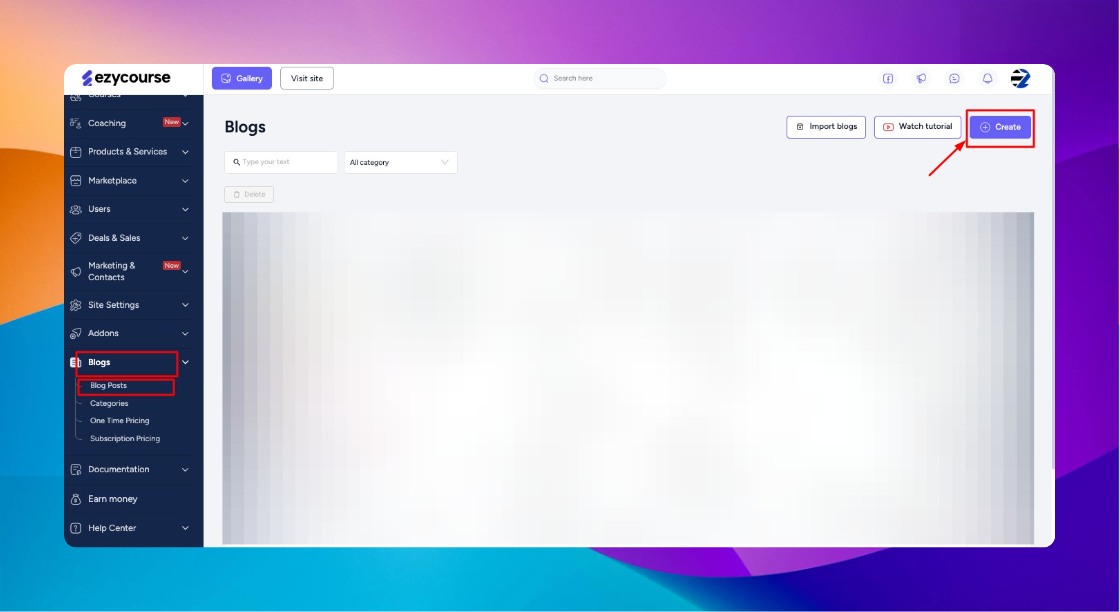
What to fill in now:
Title: For example, “5 Morning Yoga Poses to Energize Your Day”
Then click on : Allow users to comment on the blog & Show Published Date

Content: Use the rich text editor to write your blog. You can:
Add headings, paragraphs, bullet points
Insert images or videos (upload directly or embed)
Add links to your courses or external sources
Step 3: Organize Your Blog with Categories and Tags
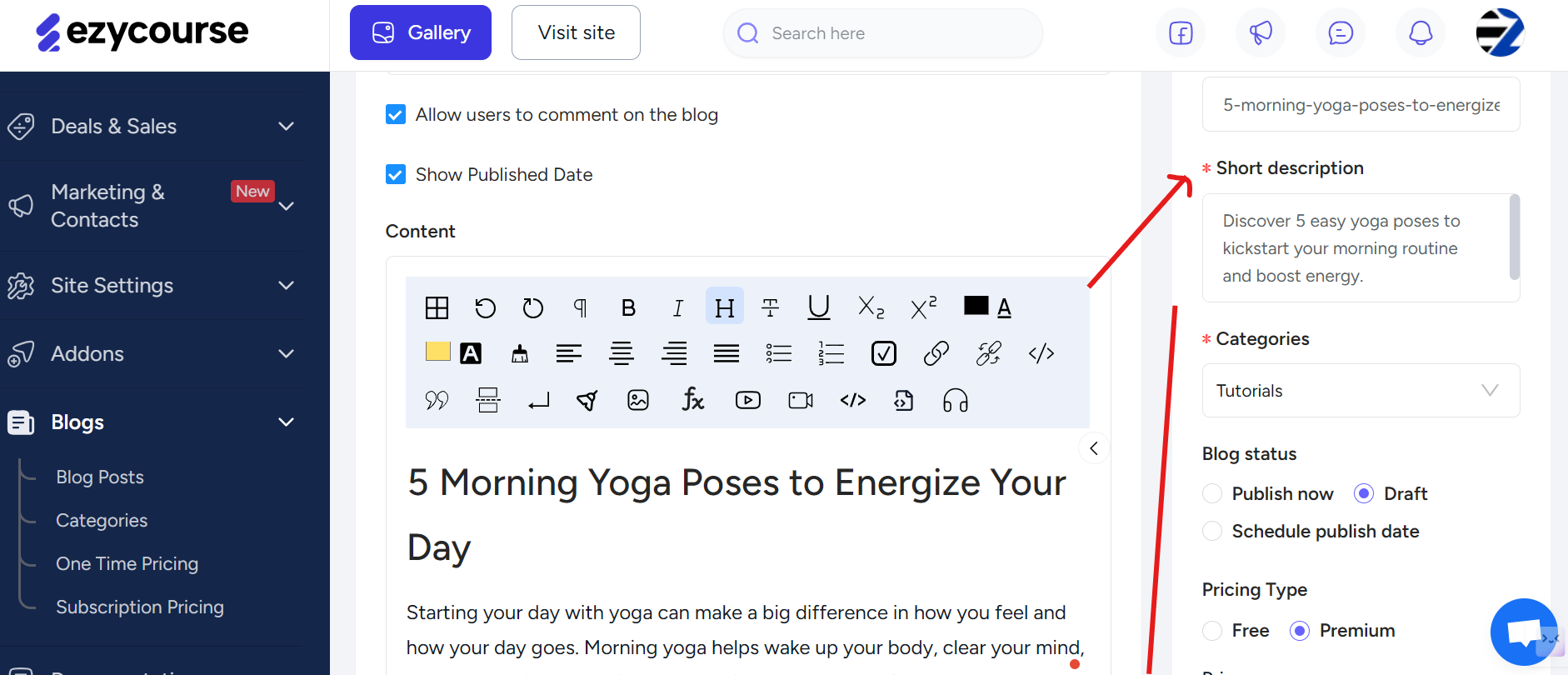
Under the blog editor:
Short Description: Discover 5 easy yoga poses to kickstart your morning routine and boost energy.
Blog Status
Choose:
Publish Now (to go live immediately)
Save as Draft (if still editing)
Schedule Publish Date: May 30, 2025, 10:00 AM
Categories: Create categories that suit your blog topics.
Example categories for a fitness coach might be:
Select: Tutorial/Any (As you made it)
Pricing Type
Choose: Free (available to all readers)
Featured Image
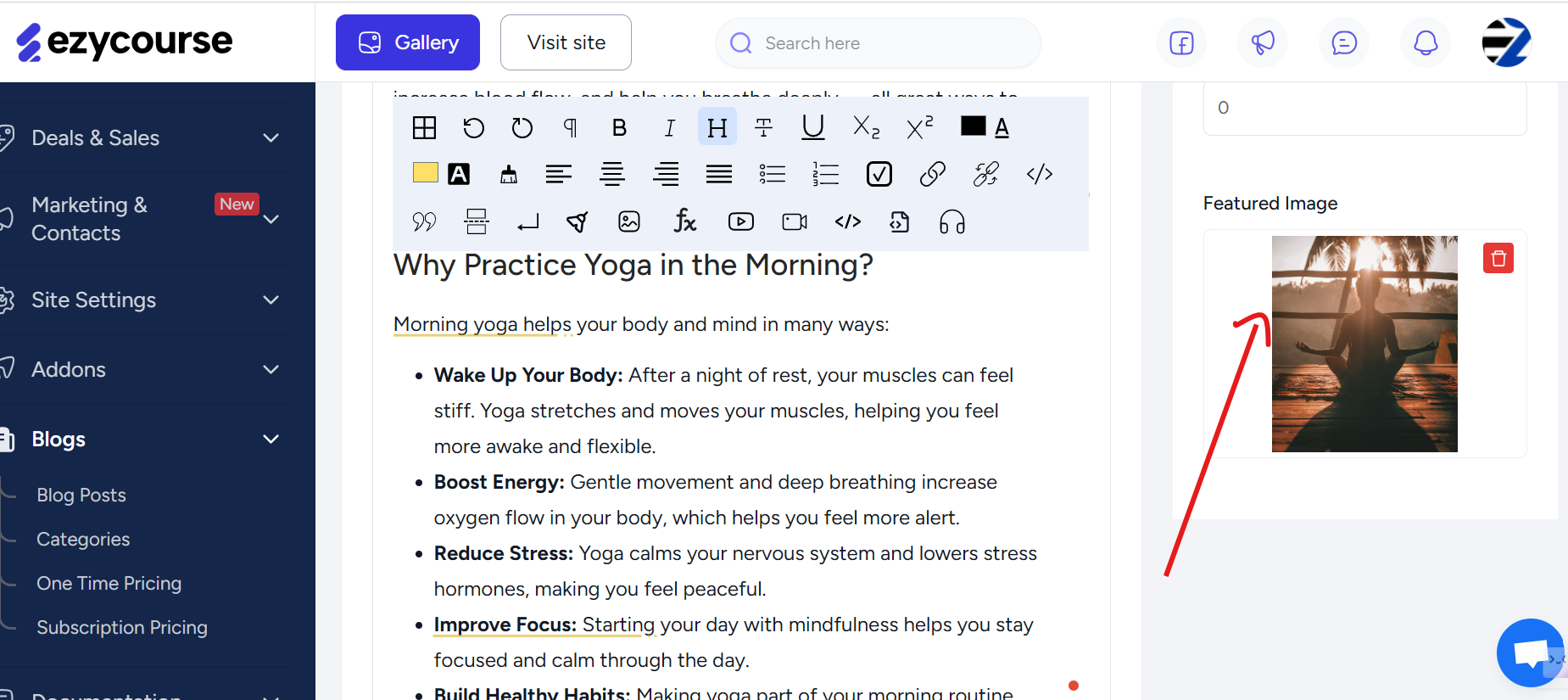
Upload: Yoga pics.jpg (1.5MB) showing a person doing Yoga. you can concise the image size with TinyPNG.
Optional - Make Your Blog Post Premium (Monetize)
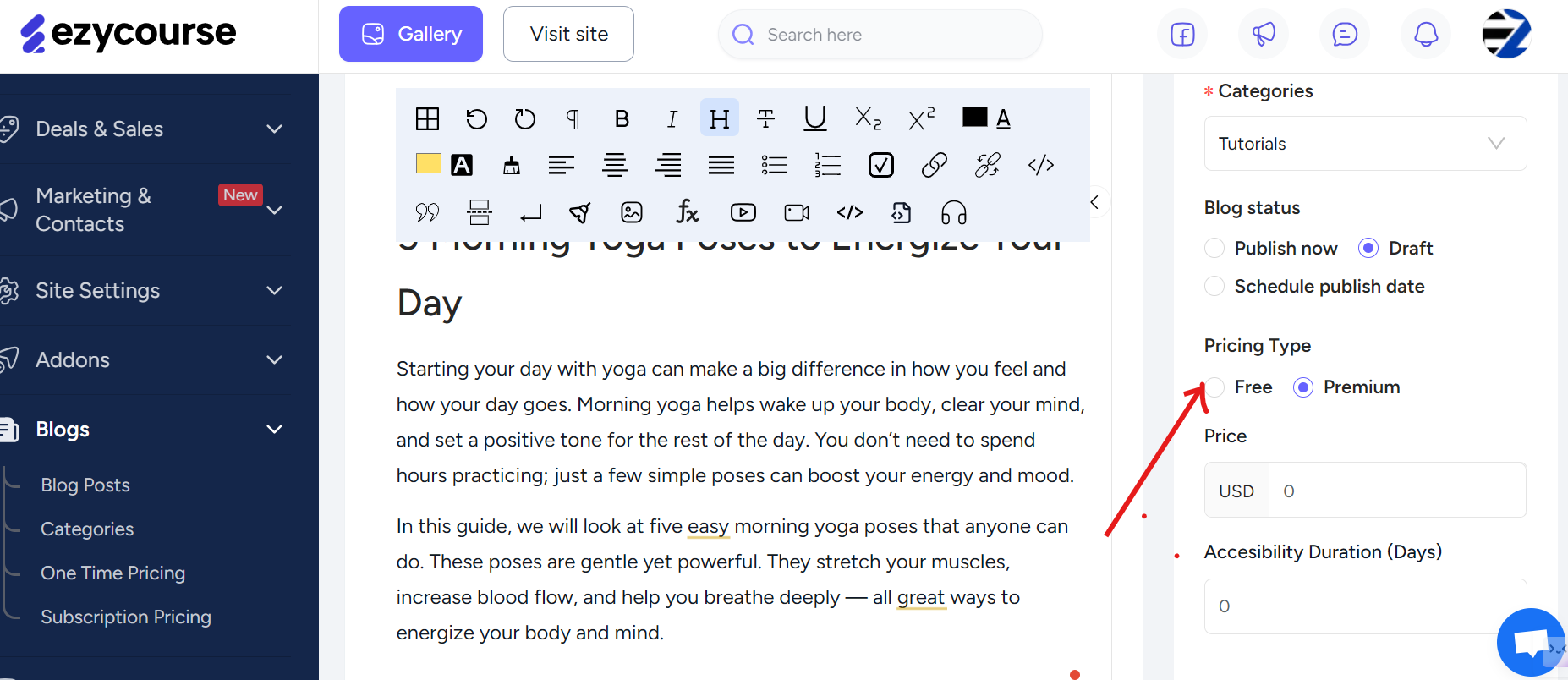
EzyCourse lets you monetize your blog by making posts premium.
In the post editor, locate Pricing.
Select Premium and set a price (e.g., $5).
You can set an access duration (e.g., 30 days) or lifetime.
Add a Teaser Text visible to everyone, enticing users to buy full access.
This is great if you want to share exclusive insights with paying subscribers.
Our dashboard will display the blog post like this.
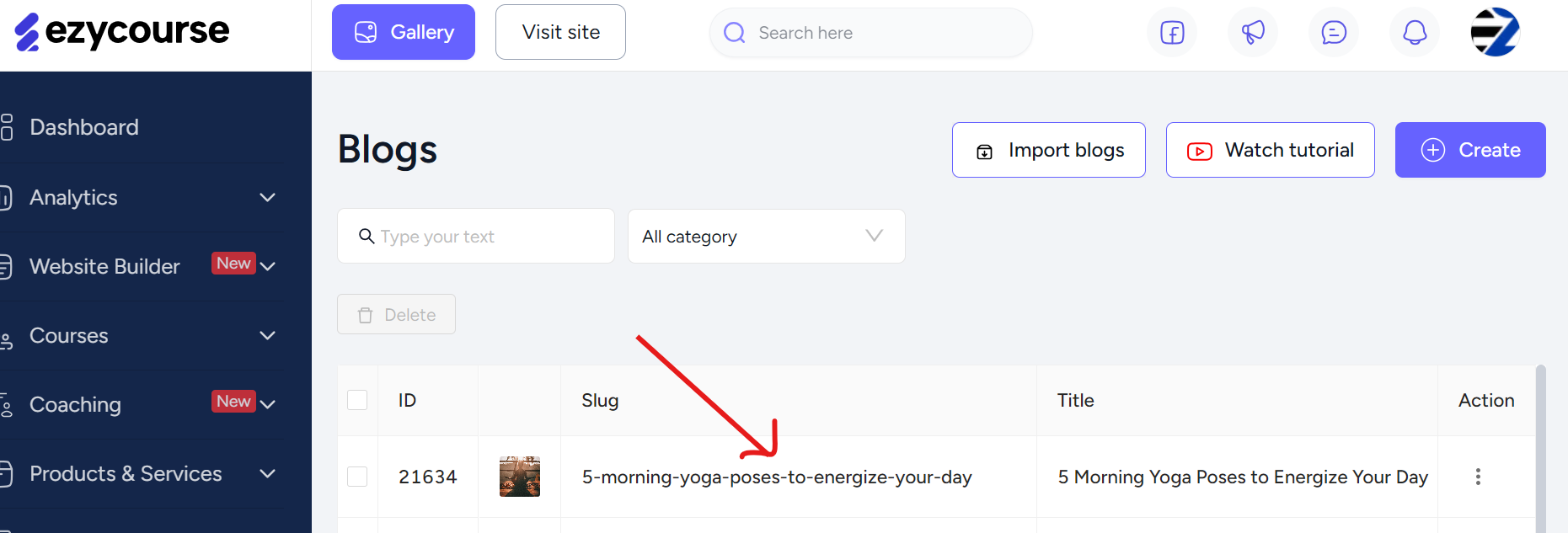
Step 4: Publish Your Blog Post

Once everything looks good:
Choose your post status:
Draft: Save your work to continue later.
Publish Now: Make your blog post live immediately.
Schedule: Set a future publish date and time.
Click Publish to go live!
Step 9: Promote Your Blog and Engage Readers
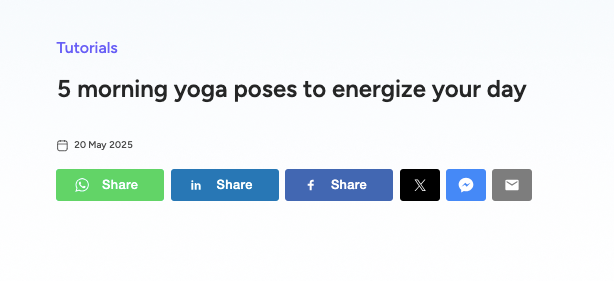
Share your blog post everywhere:
Post links on social media (Instagram, Facebook, LinkedIn).
Send blog highlights to your email list.
Link to your blog on your EzyCourse homepage.
Engage with readers:
Enable comments on your blog posts.
Respond to reader questions.
Include calls-to-action (CTAs) like:
“Enjoyed this article? Check out my full 30-day Yoga Challenge course here!”
The Last SEO Update From Google You Must Know:
The latest Google SEO update, the March 2025 Core Update, focuses on showing users the most valuable and trustworthy content. It uses advanced AI to understand better what people want when they search.
Websites with clear, original, and helpful information tend to rank higher. The update also looks at how fast pages load and how easy they are to use on phones.
Some sites, especially in health and finance, saw significant changes in their rankings. Google says there are no quick fixes if your site drops; keep improving your content and user experience. Using Google Search Console helps track these changes.
Final Say
A blog post that ranks and converts in 2025 isn’t just words on a page; it’s a carefully crafted experience. Every part, from keyword-smart headlines to clear calls to action, should work together to attract visitors, keep them engaged, and turn them into customers.
If you’re a course creator, coach, or digital entrepreneur, choosing the right platform is key. That’s why EzyCourse is here to help you.
It offers all-in-one tools to write blogs, build courses, create communities, and grow your brand without any coding or plugin hassles.
So, make your journey easier and more successful with EzyCourse. Start creating smarter today!
